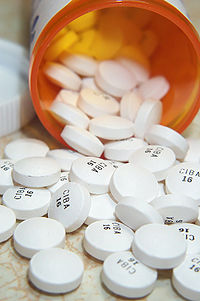
Back منبه (مادة) Arabic Psixostimulyatorlar Azerbaijani Стимулант Bulgarian Estimulant Catalan وریاکەرەوە (دەرمان) CKB Stimulans Czech Stimulans Danish Stimulans German Estimulante Spanish Erguti Estonian

Stimulants (also known as central nervous system stimulants, or psychostimulants, or colloquially as uppers) are a class of drugs that increase alertness. They are used for various purposes, such as enhancing attention, motivation, cognition, mood, and physical performance. Some stimulants occur naturally, while others are exclusively synthetic. Common stimulants include caffeine, nicotine, amphetamines, cocaine, methylphenidate, and modafinil. Stimulants may be subject to varying forms of regulation, or outright prohibition, depending on jurisdiction.
Stimulants increase activity in the sympathetic nervous system, either directly or indirectly. Prototypical stimulants increase synaptic concentrations of excitatory neurotransmitters, particularly norepinephrine and dopamine (e.g., methylphenidate). Other stimulants work by binding to the receptors of excitatory neurotransmitters (e.g., nicotine) or by blocking the activity of endogenous agents that promote sleep (e.g., caffeine). Stimulants can affect various functions, including arousal, attention, the reward system, learning, memory, and emotion. Effects range from mild stimulation to euphoria, depending on the specific drug, dose, route of administration, and inter-individual characteristics.
Stimulants have a long history of use, both for medical and non-medical purposes. Archeological evidence from Peru shows that cocaine use dates back as far as 8000 B.C.E.[1] Stimulants have been used to treat various conditions, such as narcolepsy, attention deficit hyperactivity disorder (ADHD), obesity, depression, and fatigue. They have also been used as recreational drugs, performance-enhancing substances, and cognitive enhancers, by various groups of people, such as students, athletes, artists, and workers. They have also been used to promote aggression of combatants in wartime, both historically and in the present day.[2][3][4]
Simulants have potential risks and side effects, such as addiction, tolerance, withdrawal, psychosis, anxiety, insomnia, cardiovascular problems, and neurotoxicity. The misuse and abuse of stimulants can lead to serious health and social consequences, such as overdose, dependence, crime, and violence. Therefore, the use of stimulants is regulated by laws and policies in most countries, and requires medical supervision and prescription in some cases.
- ^ Dillehay TD, Rossen J, Ugent D, Karathanasis A, Vásquez V, Netherly PJ (2010). "Early Holocene coca chewing in northern Peru". Antiquity. 84 (326): 939–953. doi:10.1017/S0003598X00067004. ISSN 0003-598X.
- ^ "Russia's army is learning on the battlefield". The Economist. ISSN 0013-0613. Retrieved 20 December 2024.
- ^ Kamieński Ł (27 October 2022), "Intoxicants in warfare", Routledge Handbook of Intoxicants and Intoxication, Taylor & Francis, ISBN 978-0-429-05814-1, retrieved 20 December 2024
- ^ Rasmussen N (1 September 2011). "Medical Science and the Military: The Allies' Use of Amphetamine during World War II". The Journal of Interdisciplinary History. 42 (2): 205–233. doi:10.1162/JINH_a_00212. ISSN 0022-1953.